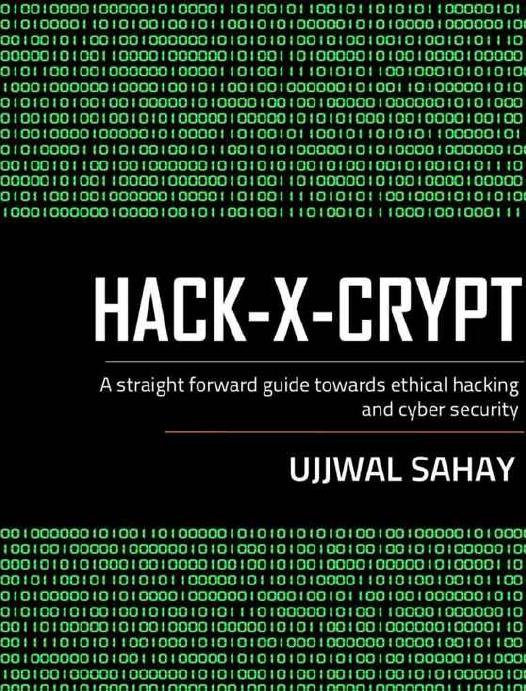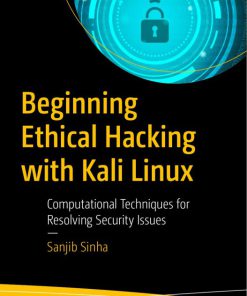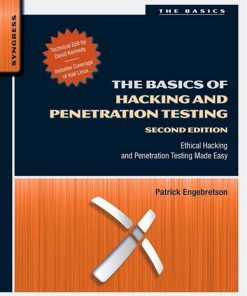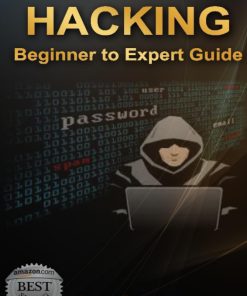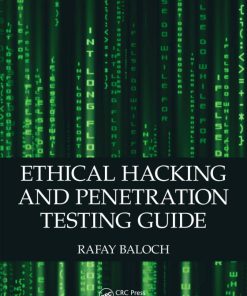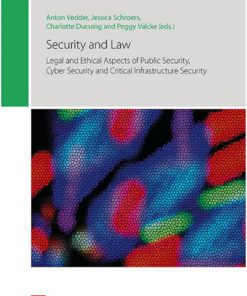HACK X CRYPT A Straight Forward Guide Towards Ethical Hacking and Cyber Security 1st Edition by Ujjwal Sahay ISBN B00V8X78DK
$50.00 Original price was: $50.00.$25.00Current price is: $25.00.
Authors:Ujjwal Sahay , Series:IT & Computer [323] , Tags:Computer Engineering; Information Technology , Author sort:Sahay, Ujjwal , Ids:Google , Languages:Languages:eng , Published:Published:Mar 2015 , Publisher:Ujjwal Sahay , Comments:Comments:This Book is written by keeping one object in mind that a beginner, who is not much familiar regarding computer hacking, can easily, attempts these hacks and recognize what we are trying to demonstrate. After Reading this book you will come to recognize that how Hacking is affecting our everyday routine work and can be very hazardous in many fields.
HACK X CRYPT A Straight Forward Guide Towards Ethical Hacking and Cyber Security 1st Edition by Ujjwal Sahay – Ebook PDF Instant Download/Delivery. B00V8X78DK
Full download HACK X CRYPT A Straight Forward Guide Towards Ethical Hacking and Cyber Security 1st Edition after payment
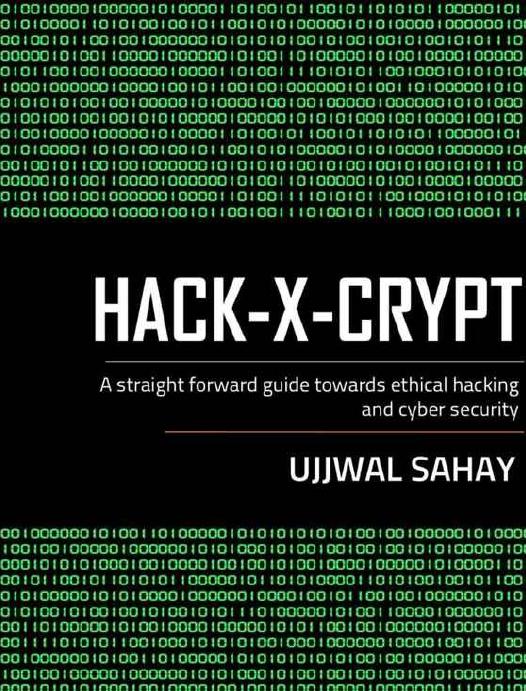
Product details:
ISBN 10: B00V8X78DK
ISBN 13:
Author: Ujjwal Sahay
This book serves as a straightforward guide to ethical hacking and cybersecurity. Computer hacking involves altering hardware and software to achieve goals that were not originally intended by the creator. Those who engage in hacking activities are commonly referred to as hackers.
While many people equate hackers with criminals, this assumption overlooks an important distinction: hackers and criminals are not the same. In reality, hackers are highly intelligent individuals who, by applying their knowledge constructively, help organizations, businesses, and governments secure sensitive information and protect online credentials.
In the past, there was little concern about cybercriminals breaking into personal computers to install malicious software like Trojan viruses, or using systems to launch attacks on others. However, times have changed, and it’s more important than ever to be vigilant about protecting your computer from harmful intrusions and defending against malicious hackers.
In this book, you will discover effective strategies to safeguard your computer systems from hackers. The book is written with beginners in mind, allowing even those with limited knowledge of hacking to understand the concepts and techniques being presented.
By the end of this book, you will gain insight into how hacking can disrupt daily activities, from financial account breaches to other serious threats. Moreover, you will develop an understanding of how hackers operate and, most importantly, how to protect yourself from these dangers.
HACK X CRYPT A Straight Forward Guide Towards Ethical Hacking and Cyber Security 1st Table of contents:
Chapter 1: Introduction to Ethical Hacking and Cybersecurity
1.1 What is Ethical Hacking?
1.2 The Role of a Hacker in Cybersecurity
1.3 The Difference Between Ethical Hackers and Criminal Hackers
1.4 Why Cybersecurity is Crucial in Today’s Digital World
1.5 Overview of Cyber Threats and Attack Methods
1.6 Legal and Ethical Considerations for Hackers
Chapter 2: Understanding the Basics of Hacking
2.1 What is Hacking?
2.2 Types of Hackers: Black Hat, White Hat, and Grey Hat
2.3 The Tools and Techniques Used by Hackers
2.4 The Phases of Hacking: Reconnaissance, Scanning, Gaining Access, Maintaining Access, and Covering Tracks
2.5 Introduction to Malware: Viruses, Trojans, Worms, and Ransomware
2.6 The Impact of Hacking on Individuals and Organizations
Chapter 3: Networking Fundamentals for Hacking
3.1 Introduction to Networking Concepts
3.2 The OSI Model and Network Layers
3.3 Types of Networks: LAN, WAN, and VPN
3.4 Understanding IP Addressing and Subnetting
3.5 Network Devices: Routers, Switches, and Firewalls
3.6 Introduction to Network Security and Protection
Chapter 4: Common Cybersecurity Threats
4.1 Phishing Attacks and Social Engineering
4.2 Denial of Service (DoS) and Distributed Denial of Service (DDoS) Attacks
4.3 SQL Injection and Cross-Site Scripting (XSS)
4.4 Man-in-the-Middle (MITM) Attacks
4.5 Password Cracking and Brute Force Attacks
4.6 Insider Threats and Data Breaches
Chapter 5: The Art of Penetration Testing
5.1 What is Penetration Testing?
5.2 Types of Penetration Testing: Black Box, White Box, and Grey Box Testing
5.3 Steps in Penetration Testing: Information Gathering, Vulnerability Assessment, Exploitation, and Reporting
5.4 Penetration Testing Tools: Nmap, Metasploit, and Burp Suite
5.5 How to Conduct a Basic Penetration Test
5.6 Reporting Vulnerabilities and Fixes
Chapter 6: Hacking and Cryptography
6.1 Introduction to Cryptography
6.2 Types of Cryptographic Techniques: Symmetric vs. Asymmetric Encryption
6.3 Common Cryptographic Algorithms: AES, RSA, and SHA
6.4 How Encryption Protects Data in Transit and Storage
6.5 Cryptographic Attacks: Brute Force, Ciphertext Only, and Known Plaintext
6.6 The Role of Cryptography in Securing Communications
Chapter 7: Web Application Security
7.1 Introduction to Web Application Security
7.2 Common Web Application Vulnerabilities: XSS, SQL Injection, and CSRF
7.3 Securing Web Servers and Web Applications
7.4 Using Web Application Firewalls (WAFs)
7.5 Testing Web Applications for Vulnerabilities
7.6 Web Security Best Practices
Chapter 8: Wireless Network Security
8.1 Introduction to Wireless Networks and Security
8.2 Common Wireless Security Protocols: WEP, WPA, WPA2
8.3 Securing Wi-Fi Networks: Best Practices
8.4 Attacks on Wireless Networks: WEP Cracking, Evil Twin Attacks, and Jamming
8.5 Tools for Wireless Network Hacking and Protection
8.6 Preventing Wireless Network Vulnerabilities
Chapter 9: Malware Analysis and Reverse Engineering
9.1 Introduction to Malware Analysis
9.2 Types of Malware: Viruses, Worms, Trojans, and Ransomware
9.3 Static vs. Dynamic Malware Analysis
9.4 Reverse Engineering Techniques for Malware
9.5 Tools for Malware Analysis: IDA Pro, OllyDbg, and Wireshark
9.6 How to Prevent and Defend Against Malware Attacks
Chapter 10: Protecting Yourself from Hackers
10.1 Best Practices for Personal Cybersecurity
10.2 How to Safeguard Your Digital Identity
10.3 Using Firewalls, Antivirus Software, and Anti-Malware Tools
10.4 Safe Browsing Practices and Avoiding Phishing Scams
10.5 Strengthening Passwords and Multi-Factor Authentication (MFA)
10.6 How to Monitor and Respond to Security Incidents
Chapter 11: Ethical Hacking Tools and Techniques
11.1 Overview of Common Hacking Tools
11.2 Reconnaissance Tools: Whois, Nslookup, and Google Dorks
11.3 Scanning Tools: Nmap, Nikto, and OpenVAS
11.4 Exploitation Tools: Metasploit, Armitage, and BeEF
11.5 Post-Exploitation Tools: Netcat, Netdiscover, and Hydra
11.6 How to Set Up Your Own Ethical Hacking Lab
Chapter 12: Legal and Ethical Aspects of Hacking
12.1 Understanding the Legal Implications of Hacking
12.2 Laws and Regulations Surrounding Cybersecurity and Hacking
12.3 The Role of Ethical Hackers in the Legal Framework
12.4 Getting Certified as an Ethical Hacker: CEH and OSCP
12.5 Ethical Considerations in the Hacking Community
12.6 How to Report Security Vulnerabilities Responsibly
Chapter 13: Future of Ethical Hacking and Cybersecurity
13.1 Emerging Cybersecurity Threats and Trends
13.2 The Role of Artificial Intelligence in Hacking and Security
13.3 Career Opportunities in Ethical Hacking and Cybersecurity
13.4 Preparing for Cybersecurity Certifications and Advanced Hacking Skills
13.5 How to Stay Updated with Cybersecurity Trends
13.6 The Future of Digital Privacy and Security
People also search for HACK X CRYPT A Straight Forward Guide Towards Ethical Hacking and Cyber Security 1st:
hack x crypt a straight forward guide towards
crypto hack answers
p-hacking example
p-hacking definition
p-hacking
You may also like…
eBook PDF
Ethical Hacking and Penetration Testing Guide 1st edition by Rafay Baloch 9781351381345 1351381342

